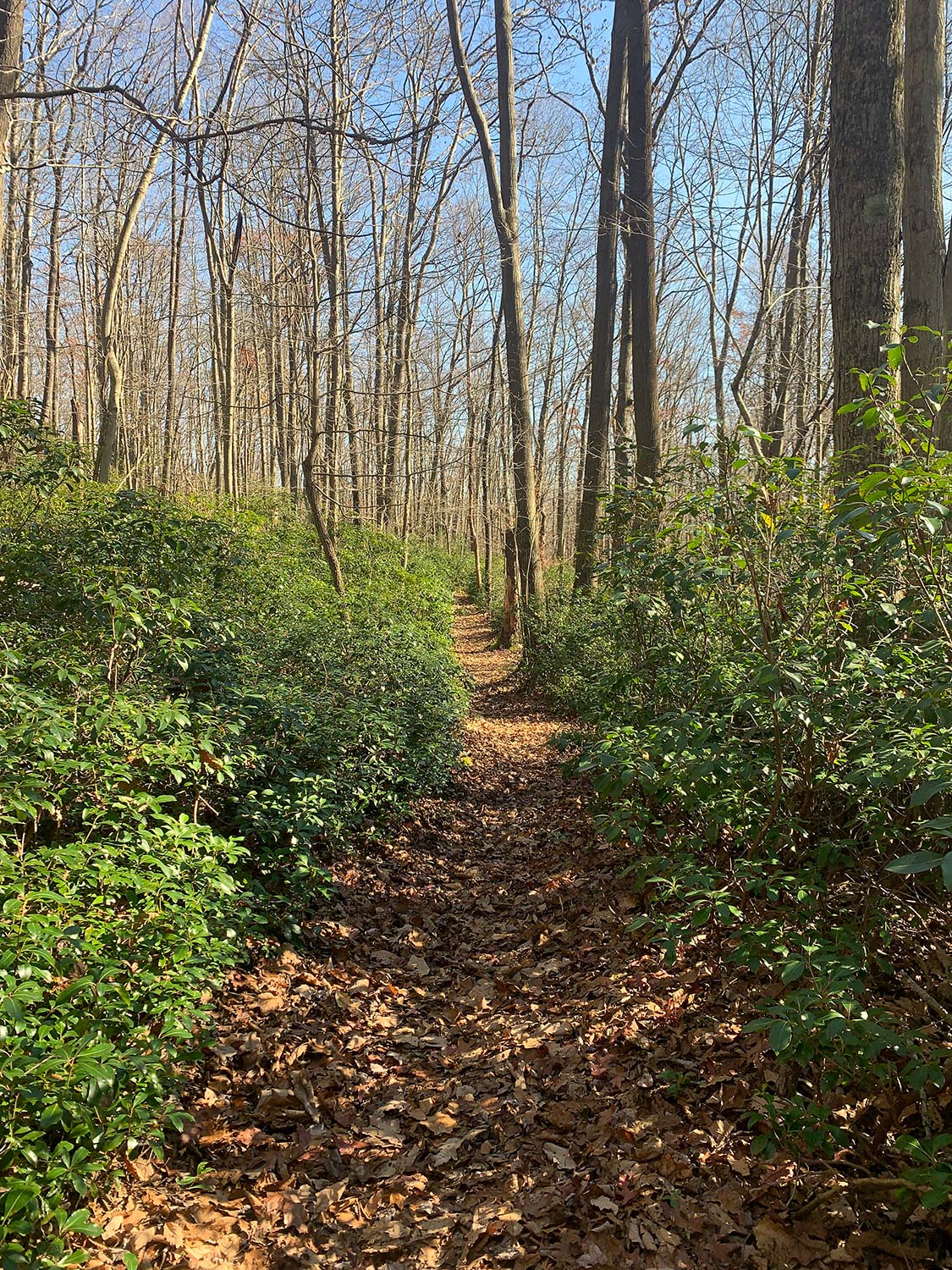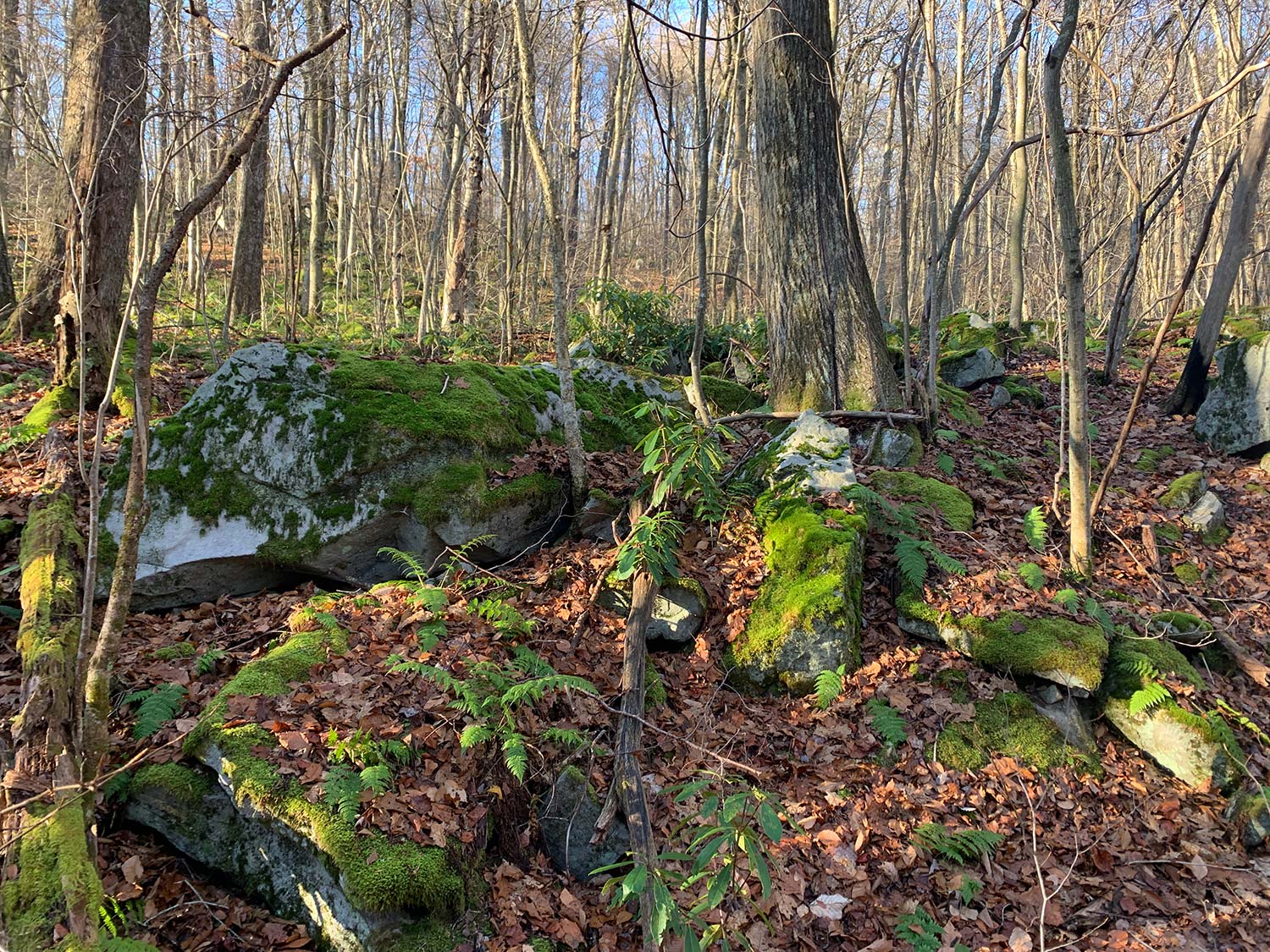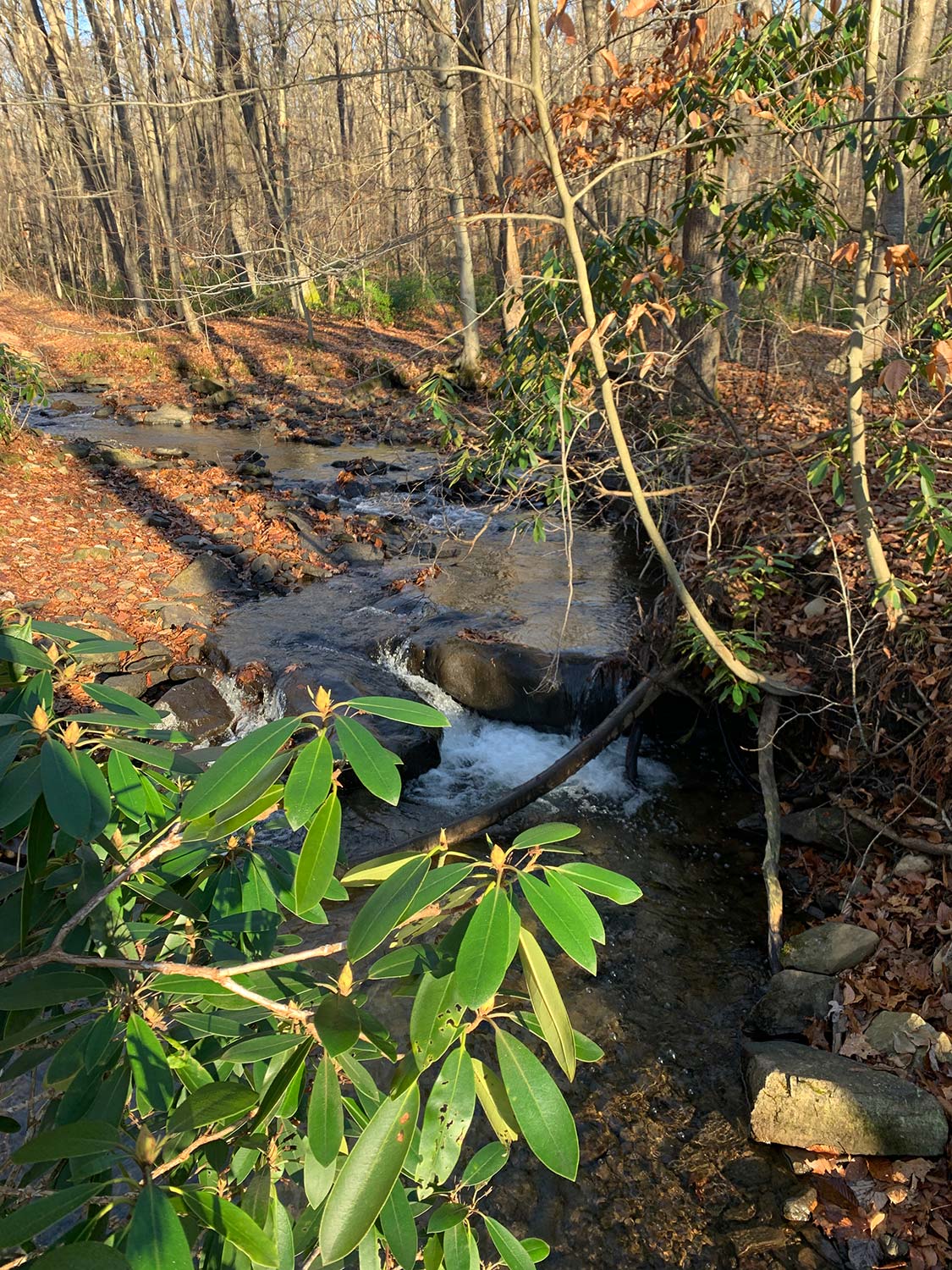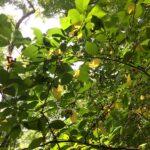
As you may have noticed, in the last month or so I’ve been working diligently on my “Sacred Trees in the Americas” series. The truth is, I’ve worked through most of the trees that are well known and form the overstory of most of the forests in the US East Coast. Trees like White Pine, Oak, Hickory, Sugar Maple, Ash, Beech, and Birch are dominant trees. And when you do research on these trees, you find a rich tradition and lore from both the Americas and the Old World. Recently, I’ve moved my attention to lesser-known trees like Ironwood and Devil’s Walking Stick, and have covered others like Witch Hazel (distinct and different from American Hazel) and Spicebush. There is a striking difference between the first group and the second: the absence of magical lore or even herbal lore on these trees. One of the things that strike me is that many of these trees form the understory, the less majestic but not less magical counterparts.
In mid-November of 2020, I was blessed with good enough weather to do a final overnight camping trip and two-day hike before the snows came. I really like hiking during the late fall and winter months; I feel you can really learn a lot about nature that is obscured in the summer. The landscape is just as vibrant and dynamic but so different. During this hike, the major theme that came to the surface for me during this time was examining the vibrancy and life of the understory. In my travels, I was walking primarily through Oak-Hickory mature forests (primarily 2nd growth trees at least 100 or more years old). These trees were bare and yet the understory flourished. The moss was an electric green color, dazzling in its intensity. The moss waits all year beneath the full shade of the overstory and then when the leaves come down, it thrives. Likewise, the three trees that really stood out to me were all understory trees. Witch Hazel in her winter bloom phase, with bright yellow flowers that look like little fireworks–that were literally lighting up the forest. Rhododendron with her showy, deep green, waxy leaves and beautifully twisted trunks, looking more tropical than ever. And Mountain Laurel, much more subdued than Rhodadendron with smaller leaves and growing much less tall–but no less majestic. The Ironwoods bent over the streams and reached up into the skies, ready to burst forth when spring arrives again.

It struck me how the understory was thriving in the winter months with the absence of the overstory and how these plants had evolved to take advantage of the winter light. The evergreen trees, the blooming witch hazel, the early-blooming spicebush, and the mosses and lichens were thriving in times of darkness and cold when everything else was cold and bare.
The metaphor of the overstory and understory weighed upon me as I hiked. Everyone pays attention to the overstory, the majestic trees is where all the awe is, and certainly, where all the logging dollars come from. We as druids are drawn to the oaks, the hickories, the ashes, the beeches. These are impressive trees, standing tall, forming groves, offering us shelter and strength. But yet, winter comes and these trees go dormant, they grow quiet, and they grow still.
And while the entire overstory was dormant, it is the understory trees that are bringing life and vitality in the winter months. The understory trees are seen as less valuable and important both in terms of magical traditions and in terms of human uses. But standing there in that forest, I realized how wrong that perception was.

These understory trees are often overlooked in our lore and in our practices. But they should not be. They teach us the lessons that we desperately need in a world that is growing ever more dark and cold. I–and many others–are under no illusion that our culture is far from a place of high summer or growth. The cost of three centuries of industrialization and stripping the land of resources is coming due. Samhain is upon us as a culture, and we are entering into a time that will be quite dark and cold for humanity. I don’t expect that this will change for the rest of my life, but rather, things will likely continue on this downward trajectory (don’t take my word for it, pick up John Michael Greer’s Not the Future We Ordered or any other peak-oil/industrial decline book and read for yourself).
My own path of druidry has, in a large part, been figuring out how to inhabit the world as it is, accepting what I can and can’t change, and helping bring forth a vision of a better world for the future descendants. The questions I often ask myself are: How do I live in a world that is in decline, that is continuing to put all life at risk, and still stay sane? How can I thrive in this time and bring hope and peace? As I walked through this powerful, vibrant understory–I realized that nature had already provided such a powerful lesson in this regard: learn to take advantage of times of darkness. Be opportunistic. Bloom when everything else is dying and the heavy frosts set in. Be flexible. Learn to become evergreen.
So to me, embracing these understory trees that manage to thrive–even blossom–in such a dark and cold time gives me hope. Let’s consider a few of their specific lessons:

Witch Hazel that blooms in the winter. I’ve written before of my thoughts on Witch Hazel and how this tree offers the critically important lesson of becoming a good ancestor, and the work of preparing the way for our descendants (physical, spiritual, or otherwise). Witch Hazel offers hope.
Ironwood, a symbol of strength and endurance. The lesson of the Ironwood I just shared–this is literally the strongest tree in the forest with the absolute densest wood. A wood that literally turns an axe aside when it is struck. If that isn’t a testament to the endurance and strength needed as we move forward in this age, I don’t know what is! And finally,
Mountain Laurel and Rhododendron, with evergreen leaves and brighten the dark. I haven’t yet gotten to share my research on Mountain Laurel or Rhododendron yet–but it is coming soon. These two understory trees add not only greenery and beauty to the forest, but they also brighten up dark places and bring light and hope back in.
Spicebush, blooming early and strong. Our spring entrant into the understory trees and plants category is Spicebush. Spicebush has one of the earliest bloom times of any plant in this part of North America, often blooming while the snow is still on the ground and with other early entrants like Skunk Cabbage. Spicebush flowers begin to set fruit just as the first leaves come onto the plant, allowing it to make the most of the late winter and early spring sun. Rise and shine!
Electric Green Moss, teaching us to make the most of opportunity. One of the most wonderful books I’ve ever read is Gathering Moss by Robin Wall Kimmerer. In this book, she shares the many stories of the moss, and some human interactions–good, bad, and otherwise–within. As I look at the beautiful electric green moss, which takes advantage of the opening up of the canopy to grow and thrive, I can’t help but think about the permaculture design principle: the problem is the solution. Facing a problem allows us to consider inherent solutions that might yet be present. The moss takes advantage of the winter to grow and thrive when everything else is dormant and dead. That’s a lesson worth experiencing.
The understory might be overlooked in mythology and in the druid tradition, but if offers rich rewards for those who seek its wisdom. I want to spend more intensive time considering, studying, the rich lessons that the understory has to offer. I hope this has offered some insight to you! What are your own experiences with the understory? How does the understory change where you live?




Reblogged this on Paths I Walk.
Reblogged this on Good Witches Homestead.
I’ve been getting this for awhile, it comes every Sunday. I find it wonderful to read, wish I could find a druid in NM who would explicate all the plants for me as well as she does for the Western PA area. Druids are the coolest people and often know so much about the natural world. They have to, they worship it. Did you know some Catholics practice druidry?
Sent from my iPhone
>
Hi Heather, thanks for reading! There are probably druids out in the New Mexico Area–start asking around on Facebook, look for groves in that area, etc ;). I wish you the best of luck in finding some druids in your area!
Heather – you would be surprised how much plant knowledge is sitting right under your nose. Check out Plants of the Southwest and SEARCH native seeds. Sprout Lands by William Bryant Logan briefly touches on the ancient history of tree care in this region, and if you look closely you will find that relationships between humans and woody plants in NM have an important factor that is often obscured by modern management styles.
Thank you! <3
You are most welcome! 🙂
For decades I have been enamored with rhododendrons and I have drawn tons of pictures of them. I have been drawn to rhodies as long as I can remember (especially when the Catawba bloom in June and when the Rosebay bloom along creeks in July).
Yeah, I feel the same. Around here, most of the major forested rivers have them, so if you kayak, you can get a nice “rhododendron” tour down the river! Thanks for reading and your comment!
There’s a slight analogy at play here, I think, in your comparison of the overstory and the understory. In Western society, the state of being active, extroverted, yang, ever-onward, always on the go etc. is highly valued, whereas it devalues passive, introverted & introspective, yin, resting/sleeping, etc. So the overstory gets the glory while the understory is overlooked. In taijiquan (more commonly known as ta’i chi ch’uan) there is always the interplay between the two, and the seemingly passive/receptive/yin movements are just as needed as the active ones. Without them, the active ones are pointless. A bowl would be useless if it lacked the depth and receptive capacity to hold nourishing food. Moving toward wholeness means recognizing all parts of anything, not just the most visible or noticeable parts.
Reblogged this on litebeing chronicles and commented:
How can I thrive in this time and bring hope and peace? As I walked through this powerful, vibrant understory–I realized that nature had already provided such a powerful lesson in this regard: learn to take advantage of times of darkness. Be opportunistic. Bloom when everything else is dying and the heavy frosts set in. Be flexible. Learn to become evergreen.
Wise words indeed. Enjoy this post from Dana that shows how Gaia can lead the way to healing. You just have to be observant and awake.
There’s a lot of understory near our home. There’s a wetland behind us and the trees are not as large, and even where they are, they often come down. So, there’s lots of life in the ground, with mosses and other life growing on the downed trees. Quite a playground, actually, which has been much-needed for human neighbors during social distancing times. I want to look specifically for Rhododendron. I have noticed them outside of gardens here, but I haven’t looked intentionally.
That sounds like a really nice place to be :). Here, you can find Rhododendron all along our mountains; it especially likes by streams, etc. There is a specific kind of forest that just is perfect with all of the Rhododendron! Can’t miss it this time of year with the beautiful green leaves.
This was a wonderful post to read (I just recently came to your blog and am working my way through all yours postings). I especially resonated with your insight of the understory – take advantage of the darkness and bloom when everything else seems to be dying. I too struggle with what I perceive to be the decline of our planet and culture – sometimes its hard not to go into a tailspin of despair. But you remind me that there are still productive, healthy, hopeful strides we can make in our own lives to be good stewards to the planet, and I thank you for it.
Also, I haven’t read Gathering Moss yet but I have read Braiding Sweetgrass and found it to be quite moving and inspiring! She’s a wonderful, insightful author
Hi Rika,
So glad you found the blog! I think that what you are describing as the “tailspin of despair” is one of the great spiritual challenges of our age. Using metaphors like this can help us find firm grounding and know that there is SO much work to do to help us all towards a better future. I have hope :). Blessings!
Witch hazel has been one of my greatest teachers.
Not that long ago, as the sum of my life finally started to make sense and I began to experiment and meander this current path, I was out foraging for incense herbs.
I was excited to find some witch hazel and began to forage some leaves.
For years I have been a delicate forager keeping the balance of the community in mind. But alas I am human and could at that time get a bit more excitable and frivolous with my harvest (not that you would ever be able to tell I was there, but still)
I guess I wasn’t listening/sensing to what the tree wanted or was willing to give up, and only listening to myself and what I thought was right to harvest.
All of a sudden,
“IGNORANT HUMAN!”
Was a booming emotion that sharply permeated my thought-waves.
(I have had many experiences with the paranormal, and for me, “thoughts that aren’t yours” are a major indicator of contact.)
It stopped me in my tracks, stunned.
I took a moment to fully realize what just happened but immediately saw the err of my ways.
I faced the the small stand and a addressed them,
Apologizing for the Innate ignorance that we humans can be programmed with, but that I was really working hard to change that.
I haven’t been back.
Now, no matter what I’m harvesting I always ask if it’s okay and wait for instruction.
(Just a comment so I can subscribe to this thread)
Blessings to you, Soloist! You can actually subscribe to the whole blog if you look in the upper right corner (desktop version). 🙂
Hello Soloist,
Yes to all of this! For a lot of us growing up in western cultures, we have to re-train yourself to recognize the agency of all natural things, including plants, and honor them. So yes, absolutely asking permission–and always remembering to do so–is an important part of the journey. The more we are able to do this kind of shifting of thinking to a place of reverence and respect, the more the spirits of the land will open up to you.
After the experience with Witch Hazel, have you worked with it in any other capacity?
I have not, unfortunately. I haven’t been back to that area since.
I tried a few months later but the trails were impassable-ly infested with tick nests.
Someone said once that if you anger a spirit of the land, give them a good long while before returning.
I made them a promise that day, I had forgotten about it until doing some research lately. When the time is right in a few months I’ll give it another try.